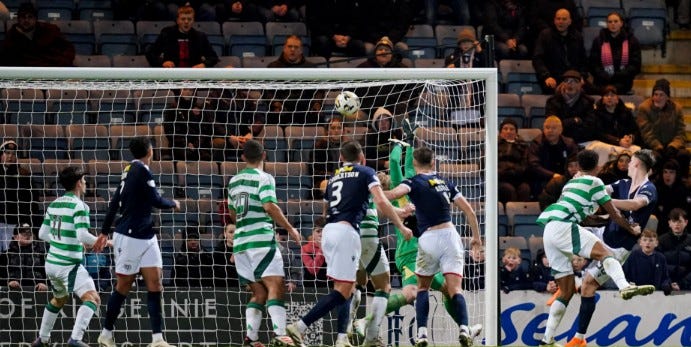A Set Play, In Two Parts
The annual review of set-piece performances both attacking and defending.
Another staple annual is to consider the performance levels achieved in attacking and defending set plays.
My perspective on this rarely changes:
1. It is an aspect of play that holds disproportional interest for the average fan relative to the materiality of the on-field outcomes; and
2. Celtic should strive to stress every margin to be as good as possible at both defending and attacking set pieces.
Like with Thomas Grønnemark and his work on throw-ins, I am far from sniffy at the opportunity to improve attacking output from anything from five to 15 goals per season. No siree. It should be vital for a club like Celtic, when competing against European opposition that is better resourced, to look for any advantage possible. And it is just the mark of a modern and progressive club to seek to be the best in all aspects of the game, but especially those not reliant on the sheer quality (and therefore cost) of the players.
At the same time, xG values generated from set piece scenarios are generally very low, and so it is good practice displayed over the season, and the attritional compiling of better quality in those aspects that count.
Furthermore, I detect that nearly all supporters at nearly all clubs are fixed into a perception that a) their club cannot defend corners effectively (“none of this zonal marking wokeness” some cry!) and b) that “we never score from direct free kicks or corners”.
Neither are entirely correct, but one does have to sit through A LOT of corners to generate a goal.
Celtic are not a side that sets out to score goals directly from corner or set-piece scenarios. And increasingly so this season. Teams in the SPFL are predominantly physically bigger than Celtic players, and more orientated towards playing for those situations in lieu of talent to open teams and finish from free play. Simple economics dictate this, especially the resource gap between Celtic and “the rest”.
Of course, some sides like Arsenal try and achieve excellence in both approaches, and it should be seen as either or. Arsenal can, of course, afford to purchase players who are both technically proficient and physically impressive.
Those further away from the top five league elite levels usually must make trade-offs.
Brendan Rodgers’s attitude to this is exemplified by his preference for Liam Scales over Auston Trusty at left centre back. Trusty is the faster, more aggressive and more dominant defender, but Scales is preferred because of his superior ball progression abilities.
In general, Rodgers aims for control of the ball, control of the pitch, and to have the ball for as long a time as possible to wear the opponents down. It can seem like any set play is simply an opportunity to continue with possession, and that certainly holds true for throw-ins, as I outlined here.
Also, it is important to distinguish between chances created directly from the set play pass and chances from secondary play – that is, a pass or three after the set piece pass.
However, this piece covers free kicks and corners, so how are we doing?
Keep reading with a 7-day free trial
Subscribe to The Huddle Breakdown to keep reading this post and get 7 days of free access to the full post archives.


